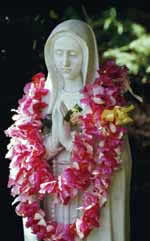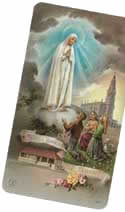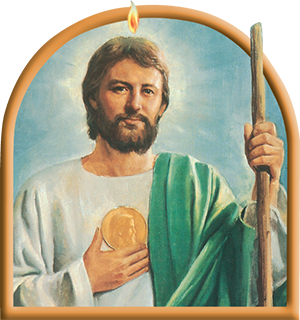Keeping up appearances
BETWEEN THE AGES OF 8 AND 10, I spent considerable time hoping for a Marian apparition. In the mid-1960s, Lourdes and Fatima were still on the lips of Catholics. I had read the books, seen the movies, been dabbed with holy water from the sites. I was Catholic, a holy communicant. I wanted it all. I wanted an apparition of my own.
I tried desperately to coax a tear from the china eye of a Mary statue in my bedroom, then I started sneaking into the Catholic church down the street and around the corner. During that magical pause after sundown and before dinner, I was alone in the cavernous church. It was dark, except for the flicker of candles on magnificent white marble altars. I would drop into a pew by the life-size Virgin Mother statue, say a few "Hail Marys," and keep watch for any small movement. A smile, a wink, a finger raised, anything to qualify as an apparition.
By the time I was 20, it embarrassed me to think I was once so earnest. By the time I was 40, the only apparition I wanted to see was my winning number in my parish's 50-50 cash drawing. Getting prayerfully woozy trying to connect with a woman who lived 2,000 years ago was not my ticket. Marian apparitions were out of style, pre-Vatican II, it seemed. Most people I knew considered apparitions ridiculous. Media reports of Marian apparitions—right up there with UFOs for many Catholics—seemed just more fuel for anti-Catholic scorn.
Our Lady of Upstate New York
Last spring, I discovered the tear-less china statue from my childhood bedroom. Mary was in the attic, wrapped in an old blanket that bulged from a faded shoe box held together by a rubber band. The discovery touched off a series of events that eventually helped me understand why apparitions draw so many different kinds of Catholics to Mary's tent, bigger than I ever imagined.
Last summer, in the backyard grotto of a Catholic church just an hour away, crowds started gathering at weekly vigils during which a local woman was reportedly having visions. My curiosity inspired, I went to see for myself. Was this a ruse or the real thing? And what is the real thing, anyhow?
In the parking lot of St. Mary's of the Lake Catholic Church in upstate New York, hundreds at a time visited the stone grotto, murmured the rosary, sang "Ave Maria," and awaited the apparent rapture of Mary Reilly, a 43-year-old shopkeeper. I went, too, captivated by the familiar Catholic culture playing out all around me.
Eyes closed, back arched, Reilly spent minutes absorbing Mary's messages of peace and love, then relayed them briefly to the crowd through friends. Many on the pavement felt they had been part of a divine moment.
I trolled Skaneateles, the pretty lakeside village where the apparitions were said to occur. I questioned the devout, with rosaries draped over their withered knuckles, and the merely curious, who shrugged. At a series of nightfall vigils, I worked the edges of the crowd, talking to a retired state prison guard, golfing grandmothers, people who stack things for a living, and all sorts of other people. Super Catholics, lapsed Catholics, Protestants, atheists. They said the same thing in different ways. A certain serenity, they said, was in the air. "The Lord is here," said Debbie Malvaso, who works as a housekeeper for a Skaneateles family. "These are all God's people. . . . I felt the spirit. I felt it strong."
Questions haunted me, though. What do visions mean? How should Catholics understand them? If you don't get it, are you still a "real" Catholic? Are apparitions for wacky Catholics? Are they reserved for the really holy ones, the ones who don't swear, rarely get cross with their kids, and go to Confession?
 |
I went back to Skaneateles the next day for the 8 a.m. Mass. I hoped a new day would clear my head and point me to someone who had the answers. Seconds after the Benediction, I cornered the parish priest. He was breezy, noncommittal.
Some women lingered after Mass. They were much more patient than the priest. They even invited me to have coffee in a little country diner with them. They were very nice, but I couldn't get to first base. The Mary thing, could they just, like . . . um . . . get to the heart of it? They smiled and turned to their margarine-soaked whole wheat toast. One woman took pity on me, let me follow her home, pet her dog, and flip through her scrapbooks. Two hours later, I drove away slowly, scratching my head.
At home, I got on the phone, a reporter's lifeline to the truth. I spoke with people consumed by the apparitions, who wanted to believe at 100 miles per hour, who bounced from one apparition tidbit to the next. Since World War II, dozens of apparitions have been reported in the United States, including cities like Cleveland, Santa Fe, Phoenix, Denver, Binghamton, N.Y., and Philadelphia. Some of the people I talked to seemed to know a little bit about each. They were blank when the scope of questioning widened. Clerics knew more than they wanted to confide. They warned me about the gullible and about those who would take advantage of them. Better for the church just to wait and see, they said.
Feeding a spiritual hunger
I was relieved when Father Johann Roten, a Marianist priest who directs the Marian Library and the International Marian Research Institute at the University of Dayton in Ohio, confirmed a hunch about some who are drawn to apparitions. They are, he says, "people who have a keen sense of crisis in contemporary culture." An increase of apparition reports in recent years, though, suggests spiritual hunger, he says, adding, "There's a groundswell going on, and apparitions are part of it." Believing in apparitions doesn't cost anything, and that in itself could be a motivator, Roten says. "It's a free lunch."
The unlisted telephone number of the Skaneateles seer was slipped to me. This was the ticket, I thought. If I could talk to the lady who communicated with Mary, well, hey, that was pretty close to interviewing God. I left cheery but professional messages. They went unanswered. The only thing left to do was to put my face in her face and hope for the best. Scary. I procrastinated by eating a hot dog at Doug's Fish Fry half a block away.
Mary Reilly couldn't have been nicer. But, no, she wouldn't talk. She referred me to her spiritual adviser. I found him on the phone in his rectory study. No deal, he said, waving me off. Bishop's orders, he said. A virtual gag order had been issued. I considered calling the Vatican, but I searched the Internet instead and read a bunch of books.
|
Officially recognized apparitions Thousands of Marian apparitions have been reported over the centuries. The few that have received official recognition by the bishop of the diocese in which they occurred include: 1531, Guadalupe, Mexico: On a hill outside Mexico City, the Blessed Mother appeared four times to Juan Diego, a recent convert to Christianity. Mary proclaimed herself the "Mother of the true God who gives life" and left her image on Diego's mantle. 1830, Paris, France: In the chapel of the Daughters of Charity of St. Vincent de Paul, Mary showed herself three times to novice Catherine Labouré. Labouré said she was commissioned by the Virgin to have the medal of the Immaculate Conception made in order to spread devotion to Our Lady. 1846, La Salette, France: 6,000 feet up in the French Alps, Mary is believed to have appeared to Maximin Giraud, 11, and Melanie Calvat, 14, while they tended sheep. Her appearance in sorrow and tears called for conversion and penance for sins. 1858, Lourdes, France: At the Grotto of Massabielle, the Virgin showed herself 18 times to Bernadette Soubirous, 14, under the title the "Immaculate Conception." 1871, Pontmain, France: Mary appeared to Eugene and Joseph Barbadette, Francoise Richer, and Jeanne-Marie Lebosse, students at a nearby convent school. Mary's message was written on a banner that unfurled from her feet: "But pray my children. God will hear you in a short time. My Son allows Himself to be moved by compassion." 1879, Knock, County Mayo, Ireland: During a pouring rain, the figures of Mary, Joseph, John the Apostle, and a lamb on a plain altar appeared over the gable of the village chapel, enveloped in a bright light. At least 15 people saw the apparition. 1917, Fatima, Portugal: While tending sheep, Lucia de Santos, 10, and her two cousins, Francisco, 9, and Jacinta Marto, 7, reported six apparitions of Mary, who identified herself as "Our Lady of the Rosary." Mary urged rosary prayer, penance for the conversion of sinners, and consecration of Russia to her Immaculate Heart. 1932-33, Beauraing, Belgium: Mary is believed to have come 33 times to the playground of a convent school to five children. Identifying herself as the "Immaculate Virgin" and "Mother of God, Queen of Heaven," she called for prayer for the conversion of sinners. 1933, Banneux, Belgium: In a garden behind the Beco family's cottage, the Blessed Mother is said to have appeared eight times to Mariette Beco, 11. Calling herself the "Virgin of the Poor," Mary promised to intercede for the poor, the sick, and the suffering. Source: Marian Library, University of Dayton, Ohio |
I called Marian apparition experts, people who had spent a lifetime collecting and analyzing apparition information. Each had a different explanation.
Sandra Zimdars-Swartz, a professor of religious studies at the University of Kansas and author of Encountering Mary: From La Salette to Medjugorje (Princeton University Press), has trekked across Kentucky, Arizona, Ireland, Italy, and the Balkans in search of believers.
People from all economic and social strata embrace the messages, Zimdars-Swartz says, recalling a manicured apparition site in an upper middle-class neighborhood in Marlboro Township, New Jersey. Everybody, it seemed, was there. From Asia, South America, the Slavic countries, and around the corner, they "brought Mary with them. . . . They were all in this guy's back yard."
Michael Cuneo, who teaches sociology and anthropology at Fordham University in New York City, has developed a sort of formula, with Marian apparitions rooted in the lower working class. "If you are a Marian seer, your expectation is that it will become popular and that many people will deem your apparitions as authentic. The hope is that it will attract a crowd. Overwhelmingly, seers are pretty humble people of modest means" who intend for their private revelations to be publicly consumed, Cuneo says.
What people see and hear is often less than gentle. "In popular Catholic imagination, Mary is often seen as infinitely solicitous and maternal," Cuneo says. "But in a lot of apparitions she has a vengeful quality."
The politics of apparitions
Apocalyptic messages delivered by Mary in admonition for the world's errant ways? Yes, especially if the interpreter is ultraconservative, it seems. The more conservative the channels, the more likely a Marian message of impending doom. Apparitions are a gray area and are easily manipulated. Belief in them is permitted by the church but not required. It is one of the few places Catholics have such wide latitude.
Only a few of the hundreds of Marian apparitions reported in the 20th century have been declared authentic by the church. Most reported apparitions have a "no decision" status. No Marian apparition reported in the United States has received an official "yes" from the Catholic Church. Bishops still make the official Catholic call with apparitions, and since the Middle Ages, only a handful have made the cut (see box at left).
The bishops, however, are careful not to dismiss the faithful with apparitions that merit only "no decision." Note this excerpt from a document generated by the Special Assembly for America of the Synod of Bishops: "Within the church community, the multiplication of supposed 'apparitions' or 'visions' is sowing confusion and reveals a certain lack of a solid basis to the faith and Christian life among her members. On the other hand, these negative aspects in their own way reveal a certain thirst for spiritual things, which, if properly channeled, can be the point of departure for a conversion to faith in Christ."
I rode around upstate New York with Marian apparition believers in hopes of picking up the answers by osmosis. One day, eating with the believers seemed a likely gateway to the truth. After a meatball sandwich for lunch in a sub place with dead plants, then a Reuben for supper in the shadow of the bar at a roadside tavern, I felt I knew even less. These people were so enthusiastic, so unquestioning, so at home with their faith in Mary and the people who see her, I was intimidated.
The search dragged on for months. I became pen pals, phone buddies, and laugh-until-you-split friends with lots of the people I interviewed.
Clockwork calling
Finally, last fall, I waited hours to interview Ivan Dragicevic. This was it.
Only a door stood between me and Ivan, who was 16 when he and five other youngsters reported in 1981 that Mary appeared to them in Yugoslavia. Books on Medjugorje have been devoured by American Catholics, thousands who were willing to travel overseas to a cow pasture in search of Mary. Dragicevic says he continues to have daily apparitions, wherever he is in the world and always at 6:40 p.m., no matter what time zone, including in front of more than 1,000 people in a corporate auditorium at the eighth annual Rochester (N.Y.) Marian Conference.
Dragicevic, however, was busy in meetings with Marian insiders. Later, he knelt on the auditorium stage just before 6:40 p.m. I joined the hushed crowd. Dragicevic—eyes closed—leaned back at an angle of about 20 degrees. His head bobbed in gentle rhythm. Ten minutes later, it was over.
Through an English speaker, he reported to the crowd: First, a bright light shone. Then, Mary appeared with outstretched arms through the light. "I only see her," he said, repeating the message he said Mary brought him. "Dear children . . . pray for peace . . . I especially ask you to pray with your families."
Women with newborns at their breasts, nurses, businesspeople, men and women in wheelchairs, elderly nuns, people from all walks of life prayed with fervor. They roared at Catholic jokes and listened to harsh words about gay marriages and the new world order. In line to use the restrooms, women confided their Marian experiences in strangers, then later snapped up Marian items from any one of dozens of vendors. There was a run on black, plastic-beaded rosaries blessed at Medjugorje.
Yet Medjugorje, where millions of pilgrims have traveled during the past 20 years, isn't an official apparition site in the eyes of the church. So what does that make what was happening in Rochester?
 |
The light goes on
In the end, it was James Howell who put my questions to rest. We've never met, but we have mutual Marian friends who met Howell on a trip to Medjugorje in 1998. "I was such a doubting Thomas," Howell recalls.
He grew up Catholic, became a hairdresser, had some wild times, and eventually found himself in the pouring rain one night on an Eastern European hillside. Prayer from the mouths of French, Portuguese, Americans, and Germans quieted: Ivan Dragicevic was having an apparition.
Two things happened that April night, Howell says, that charged his life with new energy. "During the apparition, this one bird sang its little heart out. Then, I smelled roses." The signs were from Mary, he says, and filled him with peace.
"You know when you're little and you sit on your mom's lap? It's like that," he says. "Mary has a way of getting to you. You always know you can go to your mom."
"The message," Howell says, "is very simple: Love. Unconditional, good old-fashioned love. If you're mad at somebody, get over it." Howell, a gay man, says he returned to Kansas City with the strength to live a celibate lifestyle. He also returned to Catholicism, joining an inner-city parish.
"Mary," he says, "chooses to whisper in your ear, but what you do with it is up to you."
Some see her in a dancing sun, some smell the roses, some see a radiant woman. Mary works for God, Howell says, and she delivers. "That's her . . . she's the little Volkswagen that gets you to the dealership where God is."
She drives different people in different ways, and "the one thing we all have," Howell says, "is peace."
Peace.
Mary Catt is a freelance writer who lives in the Finger Lakes Region of New York.
